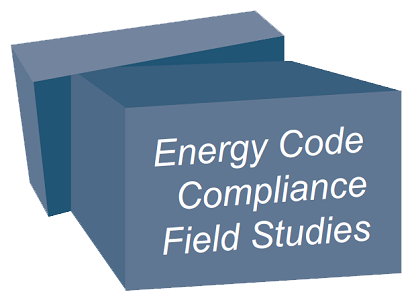Design
Consider Whether this Program In a Box is Right for Your State
This Program In a Box will be most useful to states that:
- want to measure code compliance by understanding the practices being used in newly constructed buildings (especially single-family residential buildings) in their state and how those practices align with the building code in force.
- seek to develop or improve building code training efforts, especially in states that have recently adopted new building codes.
- are considering building code updates and would like to understand current building practices.
Justice40 Considerations
Through Executive Order 14008 which established the Justice40 Initiative, the Biden Administration has set a goal of ensuring that at least 40 percent of the benefits of federal investments flow to disadvantaged communities. Justice40 will have significant implications for hundreds of programs across the federal government, including clean energy, climate, and resilience programs that are overseen by the U.S. Department of Energy (DOE) in partnership with states. State Energy Offices and their partners may wish to consider assessing various dimensions of their programs – including such factors as the ability of disadvantaged and diverse individuals and communities to influence, participate in, and access the benefits of state policies and programs – and explore metrics and reporting strategies that will help illustrate the Justice40 impacts of their policies, programs, and investments. Available resources to support these actions include:
- White House landing page for Justice40
- July 2021 Office of Management and Budget Interim Implementation Guidance for the Justice40 Initiative
- Justice40 Initiative Updates from DOE’s Office of Economic Impact and Diversity
- Guidance on Community Benefits Plans in Proposals for IIJA Funding
- January 2023 Addendum to the Interim Implementation Guidance for the Justice40 Initiative, M-21-28, on using the Climate and Economic Justice Screening Tool (CEJST)
- Instructions for using the Climate and Economic Justice Screening Tool
Through NASEO’s Energy Equity Committee , State Energy Offices can learn about ongoing developments and resources that support federal Justice40 and state energy equity and environmental justice goals.
To help states identify the location of disadvantaged communities, the White House Council on Environmental Quality (CEQ) has developed The Climate and Economic Justice Screening Tool (CEJST) . Instructions for using the tool are linked above.
Goals and Name
Writing a concise goals statement for a new study on energy code compliance will help to create internal consensus and to communicate with municipalities and code officials. Having a written goal helps articulate how the data collected from the study will be used to improve code compliance through education and training efforts. For instance, the goal of DOE’s original funding opportunity announcement was to “determine whether an investment in education, training, and outreach programs can produce a significant, measurable change in single-family residential building code energy use, and therefore energy savings, within 2-3 years.” Consider your state’s capacity for educational activities and whether this is a worthwhile goal for studies in your state.
Giving the program a name is an important step in the process of branding and advertising the program.
Recommendations for program name:
- Reflect the goals of the program
- Solicit recommendations from participating agencies and organizations
Proposed action items:
- Align study objectives with state policies and goals
- Finalize the program name
- Craft a goals statement
- Craft a one-page program description to support consistent communications
Performance Metrics
Specific performance metrics for this program include improvements in code compliance following educational activities. The most important overall metric is reducing the overall energy consumption the homes sampled through education activities. The specific measures tracked will depend on your states sample. Some potential specific measures to track before and after educational activities include duct leakage, envelope air leakage, lighting efficiency, ceiling insulation, foundation insulation, exterior wall insulation, and window solar heat gain coefficient.
Eligibility Criteria
All states are eligible to use DOE’s methodology to complete residential energy code compliance field studies.
Budget and Staffing
Before finalizing the program design, it is important to consider budget allocations and staffing requirements. In studies conducted thus far, project teams have included State Energy Offices, other state agencies, Regional Energy Efficiency Organizations (REEOS), nonprofit organizations, consulting firms, and PNNL. The number of parties involved in studies conducted thus far has ranged from three to ten. The number of parties need will depend on the scope of assistance offered by each party and the involvement of state agencies in the study.
Scale and Scope
As your state determines the scope and scale, consider the scope and reach of the education and outreach efforts that will follow the field study and the State Energy Office’s role in administering the program. In the case of a study NASEO is conducting scope of educational activities includes recruiting and training 4-5 experts on energy codes in both the states of Colorado and Nevada and providing in-person energy code trainings, webinars, and presentations to builders, building officials, and building raters. The scope and scale of the educational activities will be dependent on staffing capacity and the number of builders, building officials, and building raters that require training. The following documents pertain to a field study NASEO is conducting in Colorado and Nevada:
Timeline
Part of the program design is looking at the budget and determining a realistic timeline for completing a study and selecting the duration of the study. The International Energy Conservation Code (IECC) is updated every three years, although your state may update on a different cycle. Consider the IECC update cycle and your state’s update cycle when planning timing. When developing the timeline, consider the number of new residential buildings constructed each year in your state and the seasonal cycle of construction activity in your state (cold snowy winters that stop or slow construction activities may make it more difficult for data collectors to obtain access to construction sites).

